Are you ready to go on an epic Peloponnese road trip around one of the most underrated parts of Europe? The Peloponnese Peninsula is often an afterthought for most people when planning a vacation to Greece. But here we will see why that’s the wrong mindset.
If you’ve never been to a Greek island, you absolutely should plan a trip to one, even if it’s not Santorini or Mykonos. But Greece offers so much more than just the islands. Close enough to Athens for an easy road trip, and full of ancient history and stunning coastlines, the Peloponnese Peninsula is waiting for you to discover!
Note: this article contains affiliate links, which means that should you purchase something or get a quote through them I may make a small commission at no additional cost to you. This helps keep the site running with up to date information. I do not represent Booking.com, World Nomads, GetYourGuide, or Rentalcars.com. This is information only and not a recommendation to buy the product mentioned in this article.
Peloponnese Peninsula – What You Need to Know
Where is the Peloponnese Peninsula?
The Peloponnese Peninsula is southwest of Athens at the southern tip of mainland Greece. It’s large and consists of many smaller peninsulas. While mountainous and rugged, there is an extensive road system throughout the peninsula, including a few motorways (which charge modest tolls).
How to get to the Peloponnese Peninsula
You will most likely be flying into Athens, though if you are located in Europe already, many cities offer seasonal flights to Kalamata. From Athens you will you need to rent a car. It is possible to take a bus to Kalamata and other cities, but you will miss out on nearly everything the peninsula has to offer by not having your own wheels.
Car rentals are still pretty cheap in Greece, even in the post Covid inflation era, and it is so worth it to have your own vehicle. From Athens it’s about a 1-hour drive to Corinth, the start of the peninsula.
You can book your rental car from the Athens airport here.
The other option is to take an organized tour. There are a ton of organized tour options around the Peloponnese. Most of these are multi day tours from Athens and they focus on this archaeological sites. Some class Peloponnese options are are:
- 4-Day Tour of Mycenae, Epidaurus, Olympia, Delphi & Meteora
- 4-Days Classical Tour with Meteora
- 6-Day Peloponnese, Cog Railway & Zakynthos Tour
There are also a few options to see some Peloponnese highlights as a day trip from Athens if you are not planning a road trip. You can check out these options a this link.
If you’re on a Peloponnese road trip driving yourself around you won’t really have any use for these tours. Sometimes it’s nice to take a break and have someone else to drive you around though!
Weather and when to visit
Wonderful weather blesses this part of the world. Even in January it can be warm enough to swim in the sea. Summers are hot and dry and getting hotter and drier each year. It’s a semi-arid climate so even in winter it’s likely to be sunny, with mild temperatures. It doesn’t really get cold unless you’re high in the mountains.
Any time of year is ideal for a Peloponnese road trip. My 2020 road trip around the Peloponnese was in the middle of winter, and I’d totally do it again. The archaeological sites throughout the country are half price in the winter. But it did mean that a lot of restaurants were not open.
In Greece, many restaurants and shops are seasonal, meaning they only operate from about April to October. There will still be some restaurants open everywhere though.
Summers get busy with all the organized bus tours and European tourists flocking to the warm sunny beaches and it can just be so damn hot. The best time to go would probably be in early October or early May, before the crowds start to come and while the weather is very pleasant and the restaurants are just opening for the season.
How long to road trip
One week is a solid amount of time to explore the peninsula. You won’t get to see everything, but you will be able to hit some archaeological highlights, chill on a beach or two, and devour enough delicious food and wine to keep you satisfied.
You’ll probably combine the trip with some time in Athens and a few days on the islands. With the Peloponnese being so close to Athens, you can easily accommodate all of this in a two-week vacation.
Language
Greek is the official language. If you can’t read the Greek alphabet though, don’t worry. Road signs are also spelled out in the Latin alphabet so you will know where you are going. On top of that, many signs are in English and every restaurant you go to will have an English menu. Anyone working in hospitality will speak at least some English.
Food
Greek food is hands down one of the best cuisines in the world. There are not really any dishes local to the Peloponnese but you will find all the Greek specialties in the restaurants.
Do note, however, that in the off-season (Nov-April) most restaurants outside of populated cities will not have their usual menu available. Choices are limited to seafood, vegetables and whatever they have that day.
I was unable to find moussaka and pastitio in January outside of major cities. In that case, better fill up on some delicious Greek specialties in Athens before departing the city.
Money
Euros is the currency and you will want to carry some cash, though Greece has transitioned pretty rapidly to a card-based society. Most restaurants, even in small villages, now accept cards. I’d still recommend carrying some cash though. Things like boat tours are usually cash only.
Prices in this part of Greece are pretty cheap, especially when compared to the more popular islands and Athens. Expect to pay about 6-12 EUR for a liter of locally made wine and around 10 EUR for a Greek specialty like moussaka. Fresh caught fish will you cost you more, though.
If you’re looking for the best bang for your buck in western Europe, the Peloponnese Peninsula makes a convincing argument, especially if you’re traveling with kids and looking to cut costs.
History
You’re walking through history nearly everywhere in Greece and there is no shortage of ancient historical sites in the Peloponnese, including some of the most famous places in the ancient world. We won’t go into the history of this region in this post, but I encourage you to read about it before your trip.
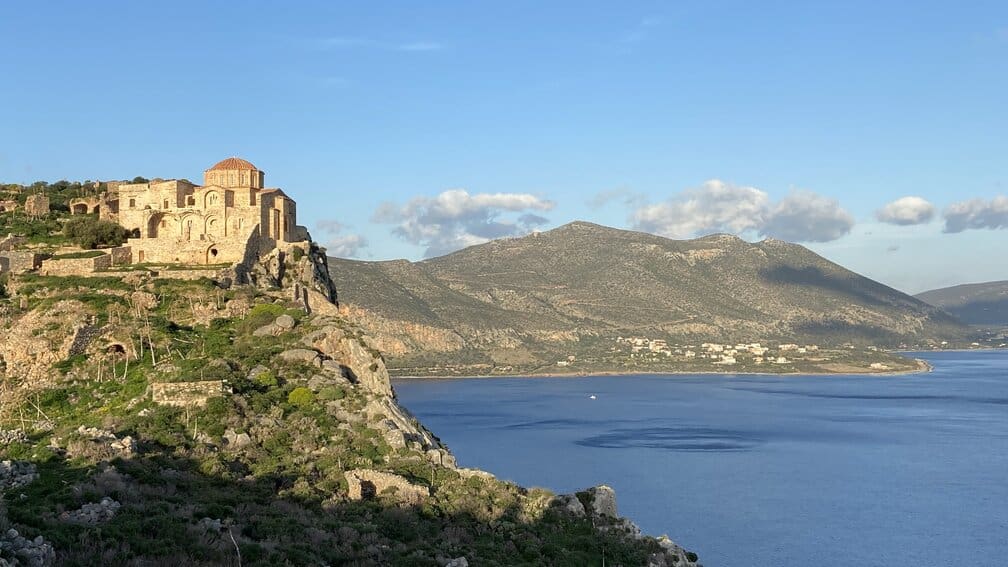
Travel insurance
Before you set out on a Peloponnese road trip, just make sure to purchase travel insurance so that you’re protected for the unexpected. As much as I loved our trip to Greece, my backpack did get stolen. Thankfully I had travel insurance! You can search for a coverage plan from World Nomads using the link below. World Nomads provides coverage to travelers in over 100 countries.
A Bad Ass 1-Week Peloponnese Road Trip Itinerary
The Peloponnese is small enough where you can see all the places discussed in this port in any order you want really. A recommended Peloponnese road trip itinerary is given below but this post is set up to discuss the sites on the peninsula individually.
I definitely recommend this itinerary as a starting point, especially if you’re going in the off season where you won’t spend time at beaches, though you might want to add on one of the other more famous archeological sites discussed below in place of Ancient Sparta if it’s your first time to the Peloponnese.
- Day 1: Arrive and spend night in Athens
- Day 2: Athens to Acrocorinth to Ancient Sparta to Sparta to Mystras
- Day 3: Mystras to Gytheio to Limeni
- Day 4: Limeni to Caves of Diros back to Limeni
- Day 5: Limeni to Vathia to Gytheio to Monemvasia
- Day 6: Monemvasia to Nafplio
- Day 7: Nafplio to Epidaurus back to Nafplio
- Day 8: Return to Athens
Peloponnese Road Trip Highlights
There are so many things to see on the Peloponnese peninsula that you won’t be able to do it all in one trip unless you have at least three weeks. You will have to pick and choose, but I will walk through some of the best places to go and things to do on your road trip around the Peloponnese.
Peloponnese Villages
The Peloponnese Peninsula is loaded with charming little villages and seaside towns. There are too many to discuss, so I will just share the places I have first-hand experience with and highly recommend.
Though I will give a shout out to Dimitsana, which is on a mountainside in the center of the peninsula. I did not make it here, but if you search through photos of this village on Instagram you will see what I mean.
Monemvasia
In the far south of the peninsula lies the beautifully preserved medieval village of Monemvasia. Monemvasia is simply stunning. The little village lies on the east side of a small island that is connected to the mainland with a paved road. There are no roads in the village itself so you must park your car outside the ancient city gates.
Once you enter the gates you will realize why no roads were ever built. Walking around Monemvasia you feel like you’re back in the middle ages. There are beautiful alleyways everywhere, as well as open squares with gorgeous eastern orthodox churches.
Hike up to the top of the mountain to the Church of Agia Sofia where you will also find ruins of part of the ancient city that used to serve as a lookout. If you go to the Peloponnese Peninsula you absolutely have to see Monemvasia. Make sure to spend at least one night in the village to really take in the beauty of the place without the daytrippers.
For the night, consider staying at Pablito House to have a great view of the city and feel like you’re staying in a medieval castle. Or check out the full listing of Monemvasia hotels on booking.com.

Limeni
This is a tiny village on the coast that oozes with Greek seaside charm. There are only a few places to stay in the village but they range from little guesthouses to luxury hotels. The water in the bay is gorgeous, even on a cloudy day.
There are limited places to eat (none of which are open in winter) but there are ample dining possibilities nearby in the town of Areopoli. A night in Limeni should be seriously considered for any road trip around the Peloponnese.
We spent two nights here as it served as our home base for scenic drives around the rugged Mani Peninsula, one of the smaller peninsulas that make up the Peloponnese. To feel like you’re staying in absolute heaven, book a night at Pirgos Mavromichali, right on the coast with direct access to that beautiful blue water.
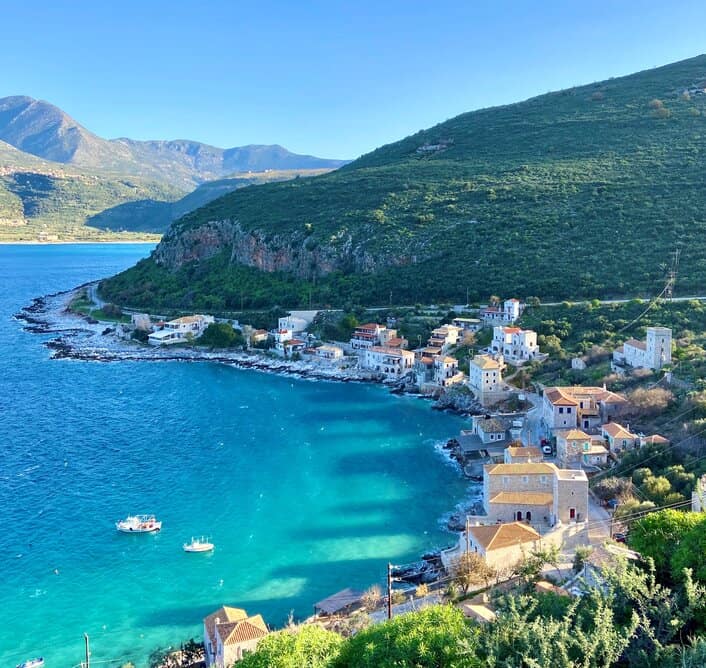
Gytheio
This coastal town is not quite as beautiful as Limeni, but there is a nice boardwalk and tons of restaurants. It’s a good stopping point on a road trip for lunch. The fresh octopus hanging out to dry was pretty enticing. I don’t have any particular recommendations for accommodations in Gytheio, but you can check out all the listing here.
Gerolimenas
Another charming coastal town with a few old buildings and wonderfully blue water. You probably don’t want to stay overnight here, but stop for a bit to walk around and enjoy the calm sea breeze.
Vathia
Vathia is an abandoned ghost town – well, one house seems to still be occupied as of January 2020 – at the far southern tip of the Mani Peninsula. It’s small and easy to wander through in 20 minutes. You can even go into the old houses and see what the people left when they abandoned their homes.
The thing that makes this village special is its tower houses. The architectural style of the village is pretty damn cool. It’s way out of the way but definitely worth stopping by if you make it down to the Mani Peninsula.
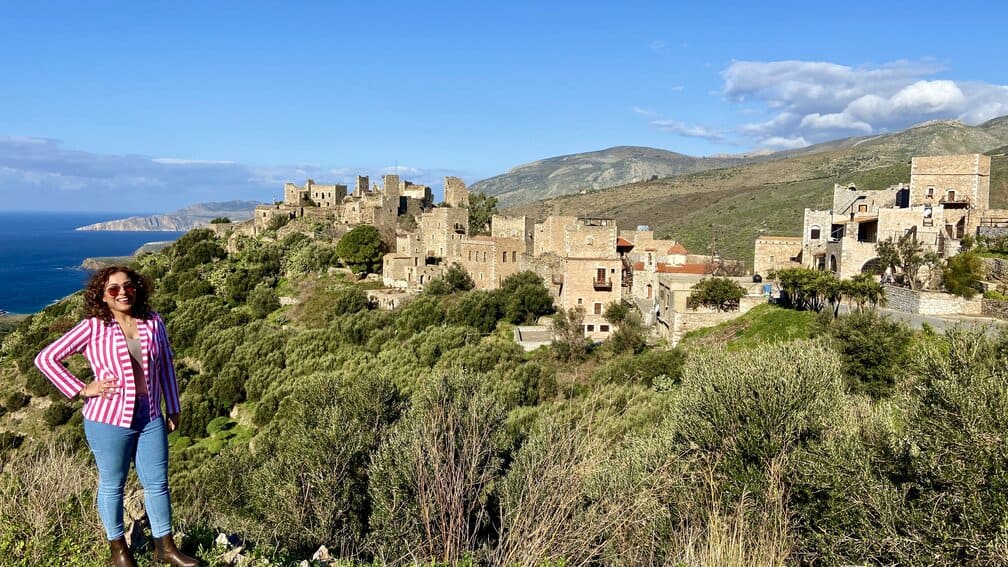
Peloponnese Archeological Sites
Greece has an epic history and the Peloponnese is loaded with historical archeological sites. I will cover the main ones here, but it’s not an exhaustive list by any means. Most of these sites are located very close to populated areas and can easily be seen without going too far off the main roads.
Acrocorinth (Free)
The Acrocorinth (and Ancient Corinth) is the remains of an ancient hilltop fortress used by the ancient Corinthians. It’s an easy hike up the mountain to the top. Ancient Corinth is the ruins of the old city at the bottom of the mountain.
Many people visit Acrocorinth as a day trip from Athens since it’s so close to the city. While on your road trip, the site is easy to see in an hour or two when driving south on Highway 2 towards the other destinations on this list.
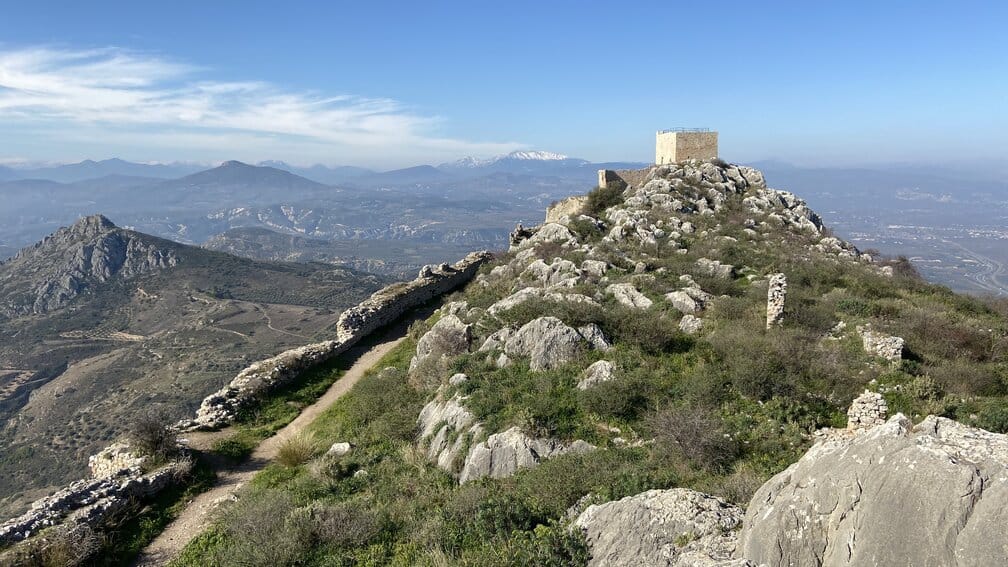
Ancient Sparta (Free)
This is Sparta! Literally, this is Sparta. Unfortunately, today there is not much left of Ancient Sparta. The ruins are not as impressive as many other sites in Greece. While it was cool for me personally to see the land of my ancestors, if you were going to skip any of the ancient sites this is probably the one to skip.
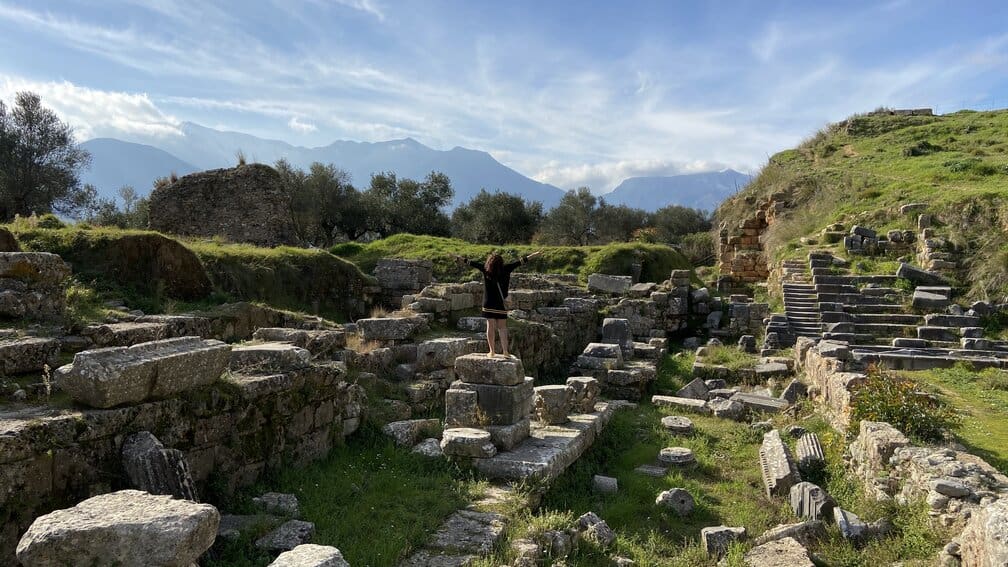
Mystras (12 EUR, 6 EUR winter)
Mystras is an ancient monastery site on the side of a mountain. It’s well preserved and still in use. The complex is vast and features a number of beautiful monasteries.
Full exploration of this site will take you up and down mountains and you should prepare to spend at least two hours exploring. Do not miss Mystras if you are heading down to the south side of the Peloponnese. It’s a stunning place!

Messene (12 EUR, 6 EUR winter)
Messene is a sprawling ancient village that is less visited than some of the other archeological sites on the peninsula due to its more remote location. It’s most known for its grand amphitheater. In terms of archeological sites in Greece, this is one of the least visited. You’ll have room to stretch your legs here for sure.
Ancient Epidaurus (12 EUR, 6 EUR winter)
Ancient Theater of the Asklepieion at Epidaurus is one of the most visited ancient sites in Greece, due to its relatively close proximity to Athens. The Epidaurus site is essentially an ancient sanctuary that was dedicated to the Greek god of medicine.
It features a massive amphitheater that was built in 340 BC as well as temples, stadiums, and a museum. But most importantly, Epidaurus features a massive amphitheater that is still in great shape for being built 2400 years ago. In fact, it still hosts concerts. If you’re short on time you can just stick to the amphitheater. It’s truly special.

Mycenae (12 EUR, 6 EUR winter)
Mycenae is the ruins of another sprawling ancient city on the peninsula. Unlike some of the other sites above, this one is heavily visited. The ancient city dates back to the second millennia BC and even had a population of about 30,000 residents at one point in approximately the year 1350 BC.
Mycenae will take at least a few hours to properly explore and truly get a sense of what life was like 3500 year ago!
Olympia (12 EUR, 6 EUR winter)
Yes, that Olympia, where the Olympics come from. You can learn all about it here. Make sure to get a run in at the Olympic Stadium, which dates back to over 1300 years BC. It might not look like much, but knowing that the original Olympics were held on that patch of crusty dirt should be enough to get your heart pumping.
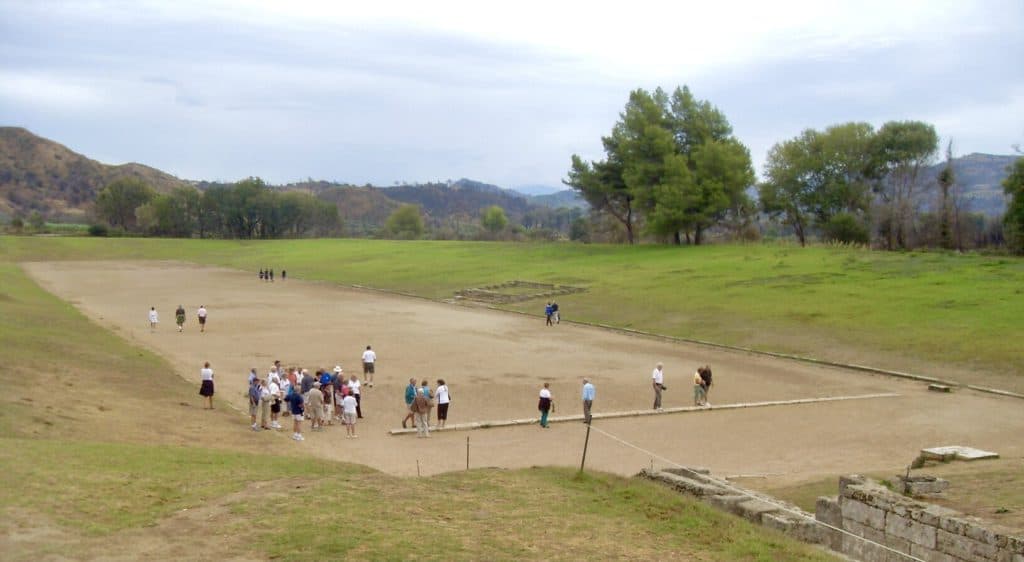
Bonus: Delphi (12 EUR, 6 EUR winter)
While not on the Peloponnese, I will also mention Delphi here. Delphi is one of the most famous archaeological sites in the world and is situated on the other side of the Bay of Corinth.
Home to the oracle of Delphi, the ancient Greeks believed Delphi to be the center of the universe It’s a bit out of the way to get there from the Peloponnese but you could build it into the final days of a road trip on your way back to Athens. It’s situated on the side of a mountain in a beautiful valley. There is also a modern town of Delphi where you can spend a night.
The list of archaeological sites in this part of Greece just goes on and on. You probably won’t even be able to fit all the ones above into your itinerary, so pick and choose. You can see now why a road trip around the Peloponnese is paradise for history buffs!
Peloponnese Cities
There are really no large cities on the Peloponnese. In this part of Greece spending time in the cities is not really the goal, but some of them are quite charming. Here is a quick rundown of the ones you have to choose from.
Patras
Patras is the largest city on the peninsula. However, I wouldn’t recommend spending your time here. It’s pretty local and doesn’t not really have a beautiful downtown or a nice waterfront or anything like that. The only highlight of Patras for us was the pork gyros we had at a little gyro place downtown for half the price you get them on the islands.
Kalamata
The Kalamata region is known for producing some of the best olives in the world. If you’re curious to tour some olive farms, a night in Kalamata might be cool. Other than that, you’re best advised to spend time outside the city in the small coastal villages. If you want to stay in Kalamata there are a ton of accommodation options, though. You can check out the listings here.
Sparti
I have a personal affliction for Sparti, as my grandmother’s family comes from here. You might have heard of Ancient Sparta. Well, that’s right here in Sparti. My friends are probably tired of me telling them I’m a quarter Spartan, but it doesn’t get old.
Sparti itself is not that great these days, mostly known for orange production. If you do find yourself in Sparti, make sure to try some orange cake, a local specialty.
If you’re passing through Sparti I recommend spending a night in the foothills of the mountains above the city. We spent one night at Luxury House in the Hills and had an amazing stay. Note that the “luxury” in the title is a bit deceiving. It’s not a luxury property and goes for about 100 euros per night.
Corinth
Corinth is another modern city from an ancient civilization, this time the Corinthians. You can go here to have a nice beach experience in a city with all the modern amenities. There are some nice resorts that offer beach vacations at affordable prices. You can stay literally on the beach for a fraction of what you’d pay at fancier beach towns.
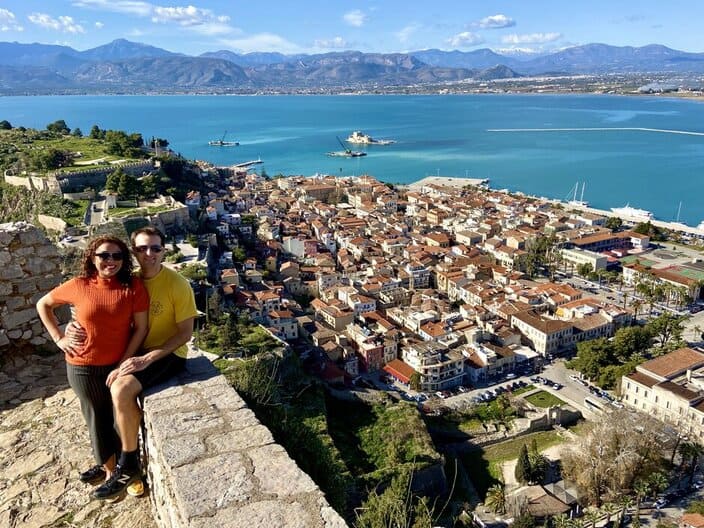
Nafplio
Nafplio is the most beautiful of the Peloponnese cities (in my opinion). If you choose to visit one of the cities, choose this one. Nafplio sits on a small, rocky peninsula that juts out of the shore.
The old town is quaint and charming and you can get a great view of it by climbing the steps to the Fortress of Palamidi. It’s a pretty strenuous climb about 30 minutes up some ancient steps, but the views from the top are spectacular.
Take a swim at Paralia Arvanitias after you come down from the fort then walk around the coast past Arvanatia Lighthouse until you get back to town. It’s a lovely walk.
In the old town, my wife and I had what we still describe as the best meal of our lives. We randomly ended up a little restaurant called Te Fanaria and we were dumbfounded by how amazing the food was. We had stuffed peppers and dolmades with some local wine and olive oil. I have never been so satisfied with food in my life. This little tavern has only has 4-stars on Google, but don’t be put off. Best meal of my life!
We spent two nights in Pension Dafni in the heart of Nafplio and highly recommended it. There are also a ton of other options in Nafplio, plenty of options for all budgets.
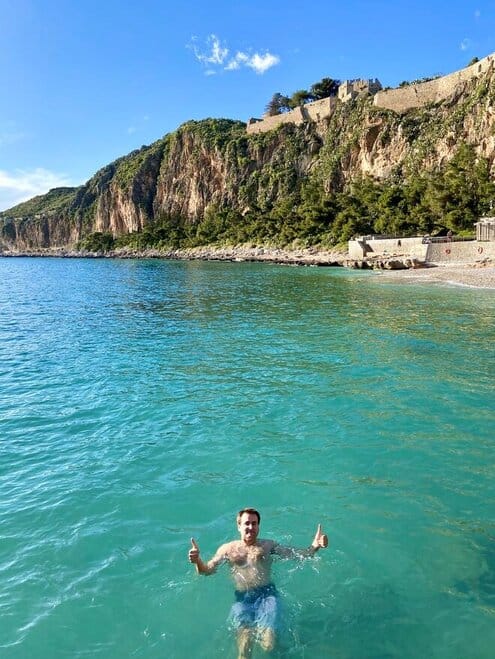
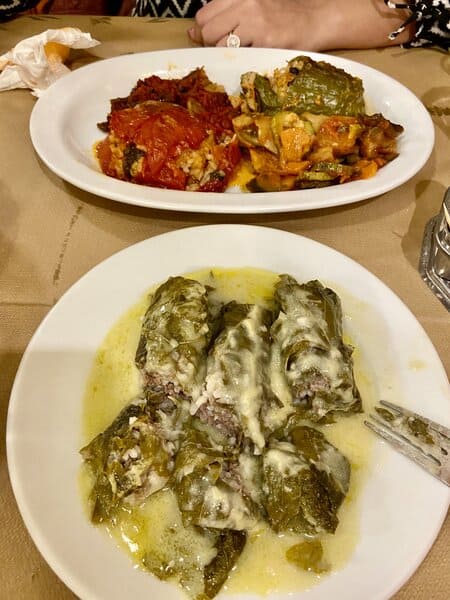
Peloponnese Beaches
While the Peloponnese is more known for its historical sites, there is no shortage of beautiful beaches to relax at between visits to ancient ruins. Below you will find a list of some of the best and most beautiful beaches in the Peloponnese that I’ve assembled.
- Voidokilia Beach: At the southwest corner of the peninsula, this beach is in the shape of a semicircle and looks simply amazing.
- Simos Beach: You will have to take a short ferry to Elafonisos Island, but this beach has that shallow clear Mediterranean water that dreams are made of. You could spend your entire week here and leave satisfied
- Limeni (see Villages section): There’s not really a beach in Limeni, but the water is so damn nice you’ll want to jump in right from the rocks
- Dimitrios Shipwreck Beach: Not quite as beautiful as the others, but the cool thing here is you can swim into a rusted old shipwreck.
- Paralia Lepitsa: A quiet little beach tucked away in a cove not too far south of Nafplio.
- Tolo Beach: Close to Nafplio, the water here is lovely. It’s more commercialized, but you’ll never be too far from somewhere to grab a cocktail.
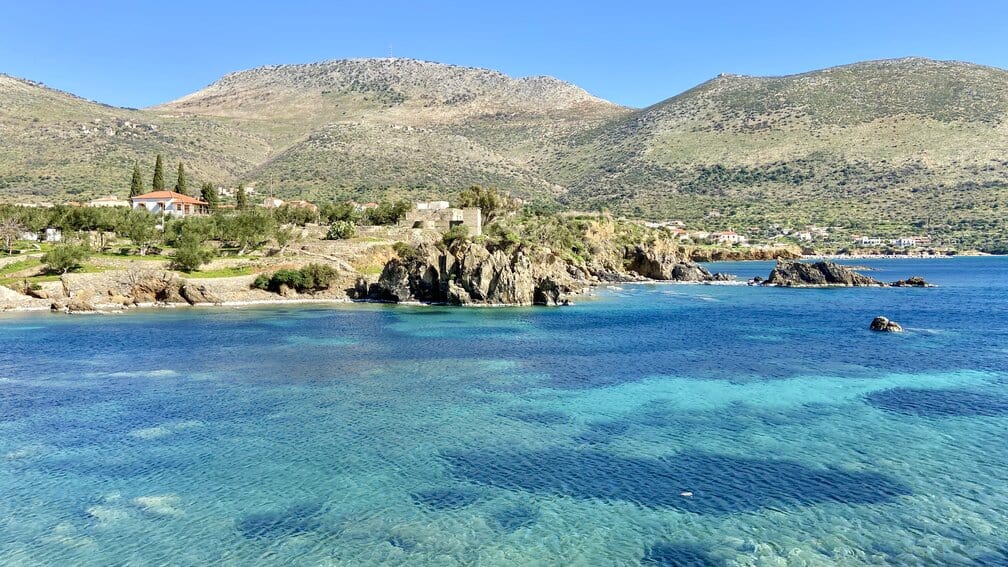
There are of course hundreds of more beautiful beaches on the Peloponnese, but this will get you started. If I had to choose one beach to go to, it would probably be Simos.
Other Things to do in the Peloponnese
There are far too many sites on the Peloponnese to list here, but one place we did not make it that we really wanted to see was Methoni Castle. This is on the west coast in the village of Methoni. It’s a bit out of the way from everything else, but it looks really cool with the castle built into the coastline.
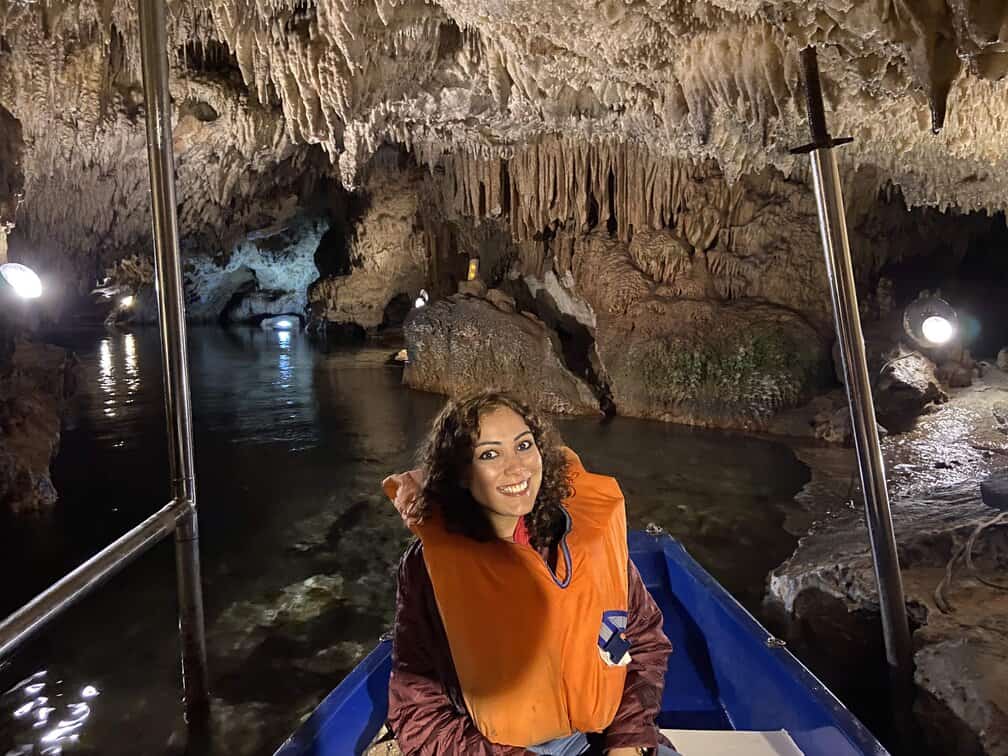
Caves of Dilos
Lastly, one additional thing I will plug here is the Caves of Dilos (15 EUR). This is a web of underground rivers in a cave and it’s the perfect thing to do on a rainy day if you’re down by the Mani Peninsula. If you are staying in Limeni it’s right down the road.
You need to take a tour since you will be in a motorboat. There is no guide though, just a captain and he probably won’t speak much English. You’ll cruise through the cave for a little less than an hour then there is a small path at the end where you can take your time and walk through the cave enjoying the stalagmites and stalactites. The Caves of Dilos are definitely worth a visit!
Peloponnese Road Trip – FAQs
How long does it take to drive around the Peloponnese?
It should take at least one week to drive around the Peloponnese Peninsula and see all the sites. While it’s possible to do it in a day or two if you’re doing nothing but driving, where’s the fun in that?
Is it worth going to the Peloponnese?
It’s absolutely worth going to the Peloponnese Peninsula in Greece. This region of Greece holds some of the most famous archaeological sites in the world, such as Epidaurus and Olympia. It also had gorgeous beaches and quaint seaside villages.
What are the roads like in the Peloponnese?
The motorways in the Peloponnese are in good condition. Nothing amazing, but they are not crumbling or anything. The main 2-lane highways are also mostly in good condition. When you get off the main roads, however, the road quality quickly deteriorates.
Large potholes are not uncommon on Peloponnese side roads. It’s also typical to see roads in dire need of repaving.
Do you need a car in the Peloponnese?
You don’t need a car in the Peloponnese if you’re taking an organized tour. Otherwise, you will need a car unless you plan on just staying in the larger cities and relying on their bus systems. Sure, you can get around without a car, but it’s just not worth it. You’ll miss too many amazing things.
Is it easy for Americans to drive in Greece?
Driving in Greece is just like driving in the US or any other western nation, with the exception of the roads are often a little more beat up. Road signs are all in English as well as Greek so there should be no problem understanding where you’re going.
Just remember that you can’t turn right on red in Europe. Refer to my guide to driving in Europe for other differences in driving between the US and Europe.
Peloponnese Road Trip – Final Word
I absolutely loved the Peloponnese Peninsula. There are not a lot of places I can say I have been to twice! The culture, the history, the food, the natural beauty and the picture-perfect coasts. It’s more than you could ever ask for in a vacation.
I’m dying to get back to this part of Greece just thinking about it. If you have any further recommendations for what to do in this part of the world leave a comment below.

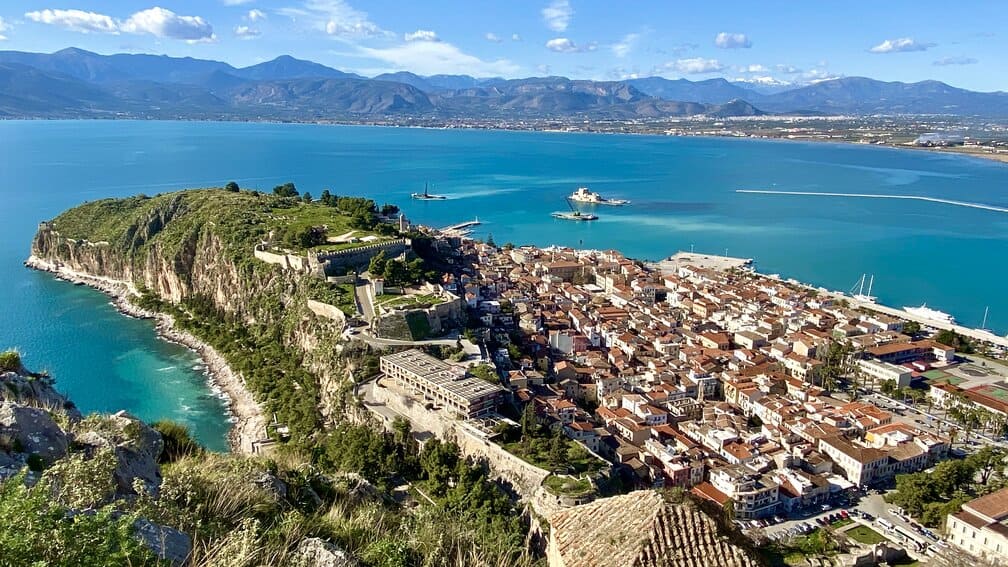
8 comments
[…] © – Around The World With Me […]
[…] is definitely worth visiting while in Greece, either as part of a longer Peloponnese road trip or as a day trip from Athens. Many group tours include it as a half day stop so if you don’t […]
[…] Source : https://aroundtheworldwithme.com/peloponnese-peninsula/ […]
[…] If you’re looking for a warm European getaway for January, look no further than Greece’s historical Peloponnese Peninsula. […]
[…] fruit. Andalusia is one of Europe’s top orange-producing regions, along with Sicily and the Peloponnese Peninsula in […]
[…] If you want to forget that it’s winter in Europe, look no further than Greece’s Peloponnese Peninsula. […]
[…] One of the most historic road trips in Greece can be made on the stunning Peloponnese Peninsula! […]
[…] of Europe’s best road trips is a drive around Greece’s Peloponnese peninsula. Take a tour through ancient Greek history with stops at some of the world’s most famous […]